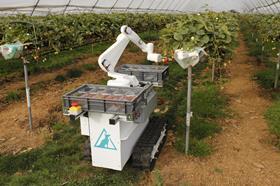
Likely restrictions to free movement have called into question farmers’ access to the eastern European seasonal workers they rely on so heavily to pick crops.
Add to this the proven fact that British workers are unwilling to fill the void – the Migration Advisory Committee estimates that Brits undertake no more than a sixth of seasonal work in UK agriculture – and you can see why some producers are doubting whether man alone can continue to pick Britain’s fruit and veg.
While access to seasonal workers from the EU remains a top priority for the industry in ongoing Brexit negotiations, with the NFU calling for the for the trial introduction of a new seasonal agricultural permit scheme, some growers are looking to increase on-farm automation as a more lasting solution to their labour concerns. The 2016 introduction of a new National Living Wage, and the apparent likelihood that farming subsidies will be cut below current EU levels beyond 2020, is putting pressure on growers to become more efficient.
Great strides have been made in packing and sorting machinery over the past few decades, with companies pushing to automate as many stages in the production process as possible. The latest trends are for improved pick and place machinery, which transfer products from one assembly line to another, and new electromagnetic linear transportation systems, according to Daniel Rackshaw of Norwich-based packaging machinery company Redpack.
“With ever-greater pressure on growers and packhouses to offer higher wages, it seems only natural for clients to automate their lines as much as possible,” says Rackshaw. “Recently we have seen an upsurge in clients employing lean manufacturing techniques utilising our machines to achieve their best return on investment.”
When it comes to robotics, the UK fresh produce sector is still in somewhat of a trial phase, with most companies only dipping their toes in the water to test the efficiency and reliability of new technology. Robotic tasks, such as screening how tomatoes grow in glasshouses, laser weeding, collecting climate data, and picking crops, have all been demonstrated by developers, but most have not made the transition to commercial use.
Exciting new technology is being developed all the time, however, with robots designed to perform even the most complicated and technical of tasks. Here is a round-up of some of the most exciting fresh produce robots:
4D plant scanner
With a throughput of 12,000 plants per hour, the 4D-Scan system from Deepfield Robotics is a master in speed in efficiency, but its real skill is its eye for detail.
The robot and cloud processing system, which is not yet being used by any UK producers, allows plant breeders to analyse the growth of their crops by making quantitative measurements of their leaf area, colour, height, emergence and mortality. Data can be uploaded and compiled from the robots all over the world, reducing the discrepancies and subjectivity that arise from using many different manual workers to monitor plant growth at different farms.
The robots, which give each plant a name and address, can relocate and identify individual plants during multiple passes on different days. This allows the system to create a history of the development of every single plant grown by a producer.
Autonomous weeding robot
Naïo Robotics’ Dino robot doesn’t just tinker round the edges, it has been designed for scale. The camera-guided weeding vehicle, which was built for large vegetable farms and is particularly well suited to salad crops, can straddle multiple vegetable beds to weed several rows of crops simultaneously. It can also be programmed to recognise cultures from certain weeds.
Frequent and precise mechanical weeding of this kind allows farmers to efficiently maintain their crops with less need for herbicides or chemical weed control products. One of Dino’s other major selling points is that it can weed crops without human supervision thanks to its guiding mechanism and weeding and hoeing tools. These instruments can be substituted, allowing the robot to perform other tasks such as sowing. Salad producers in France will begin using the robot commercially in 2017.
Smart strawberry picker
Picking strawberries, which are fragile and bruise easily, is a notoriously labour-intensive task. If strawberry picking is to be automated, only the most gentle and sensitive of robots will do, and Cambridge-based start-up Dogtooth Technologies is hoping that its machines fit the bill.
Having recently been granted £60,000 in funding from the Eastern Agri-Tech Growth Initiative, the tech manufacturer is developing robotic strawberry harvesters that allow growers to pick strawberries and collect data from each plant to enable precision crop management and optimise yields and fruit quality. The berries are graded into punnets at the point of production, adding value at source.
The machine, designed to work within narrow rows of polytunnels, inspects each strawberry as it moves along the line. With the help of a memory bank of images it decides whether a strawberry is ready for picking before a robotic arm extends, selects the fruit and places it in a punnet. Ten harvesters are currently being manufactured and will soon be offered to UK growers on a trial basis, with widespread adoption expected by 2020.



